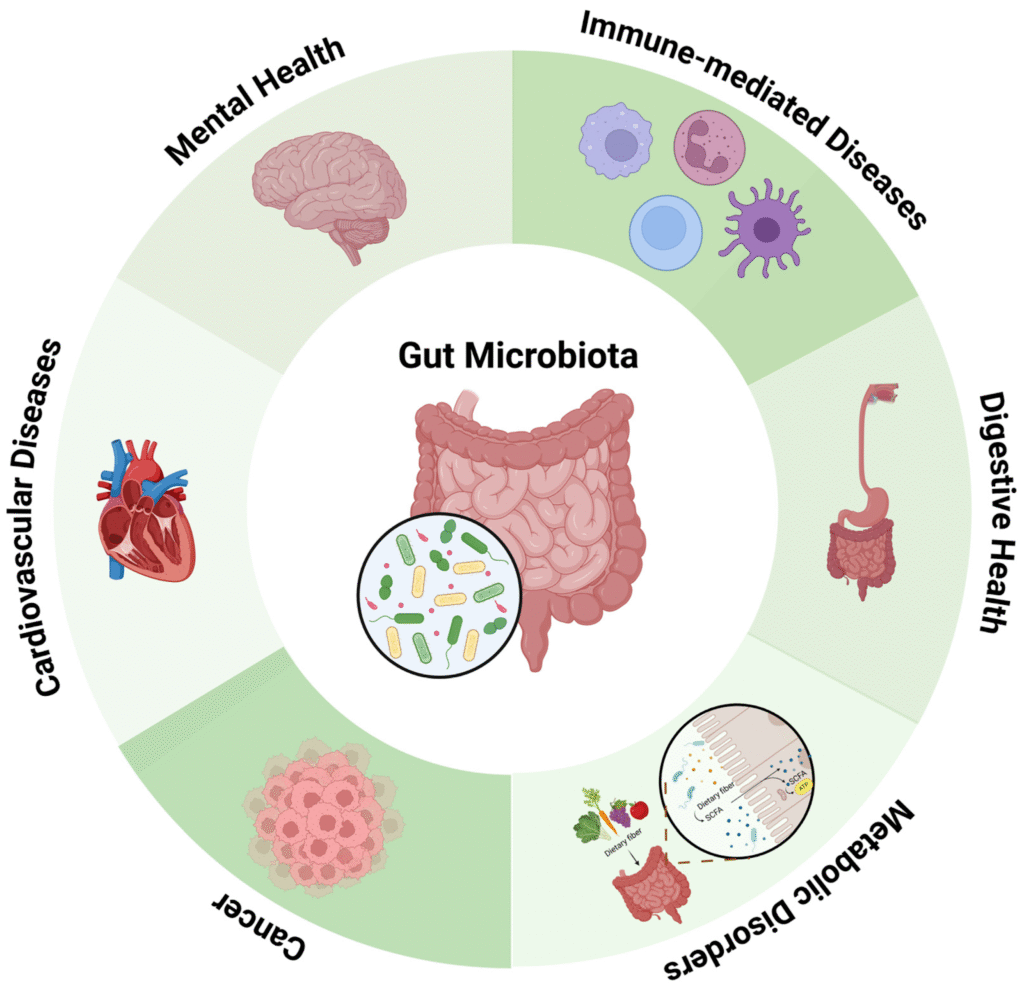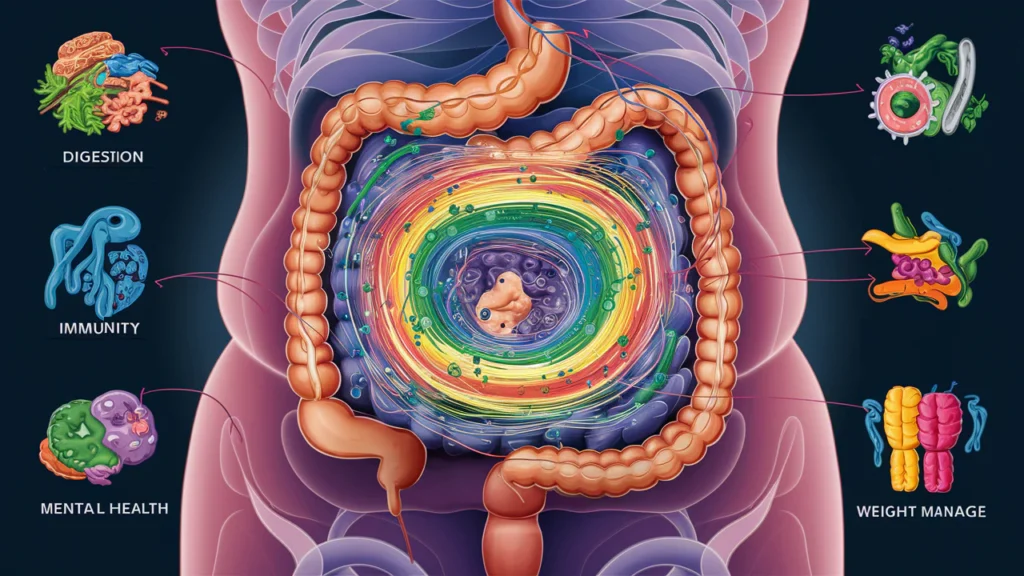
The gut microbiome is a vast community of microorganisms living in the intestines that influence digestion, immunity, and mental health. A balanced microbiome supports nutrient absorption, disease prevention, and overall body harmony.
Key Takeaways
- The microbiome forms from birth, shaped by delivery mode, feeding, and environment.
- Gut microbes produce vitamins, support immunity, and protect against pathogens.
- Diet, antibiotics, stress, and lifestyle strongly influence microbial diversity.
- Dysbiosis contributes to obesity, diabetes, inflammation, and mental disorders.
- Fiber-rich, probiotic, and prebiotic foods restore gut balance and function.
- Regular checkups and mindful antibiotic use preserve microbiome stability.
How Is the Gut Microbiome Formed?
The gut microbiome is formed through a complex process that starts even before birth and continues throughout life. Here’s an overview of how the gut microbiome is formed.
1. Prenatal Influences
For a long time, it was believed babies developed in a sterile womb, but some recent evidence suggests that limited microbial exposure might occur via the placenta and amniotic fluid. Still, major colonization begins at birth.
2. Birth Process
Babies delivered vaginally are exposed to their mother’s vaginal and gut bacteria. These bacteria become the first major colonizers. Babies delivered by C-section are more often colonized by bacteria from the skin and hospital environment, which can lead to a different initial microbiome composition.
3. Early Feeding
Human breast milk contains beneficial bacteria and prebiotics (like human milk oligosaccharides) that feed and shape a baby’s microbiome, promoting species like Bifidobacterium. Formula-fed babies tend to develop a different microbiome, often with more diverse but less specialized bacteria compared to breastfed babies.
4. Environment and Genetics
Close contact with parents, siblings, and pets exposes infants to new microbes. Living environment, antibiotic exposure, and cultural practices (e.g., diet) influence which microbes become established.
5. Introduction of Solid Foods
As babies begin to eat solid foods (usually around 4-6 months), their gut microbiome starts to resemble that of adults, with an increase in diversity and new microbial species.
6. Later Influences
Use of antibiotics can temporarily (and sometimes permanently) alter the gut microbiome by killing both harmful and beneficial bacteria. The foods we eat, stress, exercise, and illness all continue to shape the gut microbiome throughout life.
Why Is the Gut Microbiome Important?
The gut microbiome is essential for overall health and well-being due to its profound influence on numerous physiological processes throughout the body.
- Breaks down complex carbohydrates: Human enzymes cannot digest certain fibers and polysaccharides; gut bacteria ferment these substances, producing short-chain fatty acids (SCFAs) that provide energy for colon cells.
- Enhances nutrient absorption: The byproducts of microbial fermentation help the body better absorb minerals like calcium, magnesium, and iron.
- Vitamin production: Certain gut bacteria produce critical vitamins, such as B vitamins (including B12) and vitamin K, which the body cannot sufficiently synthesize on its own.
- Immune system development: The gut microbiome trains and modulates the immune system, helping distinguish between harmful invaders and harmless substances.
- Protection against pathogens: Beneficial microbes compete with and suppress the growth of harmful bacteria, providing a natural defense against infections.
- Metabolism of drugs and toxins: Gut bacteria influence how the body metabolizes drugs, bile acids, and environmental toxins.
- Prevention of chronic diseases: Imbalances (dysbiosis) in the gut microbiome have been linked to conditions such as obesity, type 2 diabetes, inflammatory bowel disease (IBD), and colorectal cancer.
- Metabolic health: A healthy microbiome helps regulate weight and reduce inflammation throughout the body.
- Mental health impact: The gut communicates with the brain via neural, hormonal, and immune pathways, a relationship known as the “gut-brain axis.” The microbiome influences mood, stress responses, and may even affect the risk of anxiety and depression.
- Critical in early life: Proper establishment of the gut microbiome after birth is crucial for immune maturation, allergy prevention, and metabolic programming in early childhood.
Key Factors Impacting the Gut Microbiome
The gut microbiome is influenced by a diverse range of factors, both internal and external. These factors can shape the diversity and composition of gut bacteria, which in turn impacts overall health.

- Diet
The single most powerful influencing factor is diet. High fiber, diverse plant-based diets support beneficial microbes, while diets high in sugar, processed foods, unhealthy fats, and artificial additives can reduce microbial diversity and promote the growth of less helpful bacteria.
- Medications
Antibiotics can drastically alter gut bacteria by killing both harmful and beneficial microbes. Other medications, such as antacids, non-steroidal anti-inflammatory drugs (NSAIDs), and steroids, may also disrupt the microbiome or gut lining. - Age
Microbiome composition changes throughout life. Infancy, childhood, adulthood, and aging each bring shifts in the types and abundance of gut microbes. - Genetic Factors
Genetics contribute to how resilient and diverse your gut microbiota may be, affecting susceptibility to changes and disease. - Lifestyle
Stress, poor sleep, lack of physical activity, and smoking can negatively affect the gut microbiome. Chronic stress, in particular, can alter gut motility and reduce beneficial microbes. - Environmental Exposures
Contact with pollutants, pesticides, household chemicals, and heavy metals can indirectly or directly harm gut bacteria, sometimes leading to dysbiosis (imbalance). - Birth and Early Life
The mode of delivery (vaginal birth vs. C-section), method of infant feeding (breastfeeding vs. formula), and early antibiotic use have lasting impacts on microbiome development. - Infections and Illnesses
Gastrointestinal infections and chronic illness can disrupt the balance of gut bacteria, sometimes triggering long-term changes. - Hygiene and Geography
Hygiene practices and where you live (urban vs. rural, country to country) can affect which microbes you are exposed to and thus your microbiome composition. learn more
How to Check Your Gut Microbiome
Checking your gut microbiome involves analyzing the types and quantities of microorganisms (bacteria, fungi, viruses) in your digestive system. This is commonly done with stool (poo) samples sent to a laboratory for analysis. There are at-home kits and clinical tests available.
- Stool sample analysis: The main way to check your gut microbiome is by collecting a stool (poop) sample and sending it to a lab. This analysis reveals which bacteria, fungi, and viruses are present in your gut.
- DNA sequencing: Most labs use 16S rRNA gene sequencing or shotgun sequencing to identify and quantify the microorganisms in your sample. Shotgun sequencing gives more detailed results, while 16S rRNA offers a broad overview.
- Commercial at-home kits: Many companies offer mail-in kits. You collect your stool sample at home and return it using the provided packaging. The lab analyzes the microbes in your sample and gives you a breakdown, sometimes with personalized diet suggestions.
- Clinical tests: In a medical setting, gut health may also be assessed using stool tests for pathogens, breath tests (to detect gases associated with bacterial overgrowth), or blood tests for markers of gut health.
Unhealthy Gut Bacteria and Its Impact

When harmful bacteria dominate your microbiome, it leads to various unhealthy gut symptoms such as digestive issues, inflammation, and even systemic conditions like obesity or Type 2 diabetes.
An overgrowth of harmful bacteria, often caused by poor diet or medication overuse, weakens the gut barrier, allowing toxins to enter the bloodstream and trigger chronic inflammation.
How to Support a Healthy Gut Microbiome
The good news is that your microbiome is adaptable and can recover from imbalances with the right lifestyle changes.
| Strategy | Details |
| Eat a Plant-Based Diet | Focus on whole foods like fruits, vegetables, whole grains, and nuts. Fiber supports beneficial bacteria and promotes microbial diversity. |
| Include Prebiotics | Prebiotics (e.g., garlic, bananas, and onions) feed healthy gut bacteria. |
| Consume Probiotics | Probiotics (e.g., yogurt, kimchi, and sauerkraut) introduce beneficial live bacteria to your gut. |
| Limit Processed Foods | Avoid highly processed foods, artificial sweeteners, and excessive sugar, which harm beneficial bacteria. |
| Manage Stress | Reduce stress through mindfulness, meditation, and yoga, as chronic stress can disrupt gut health. |
| Use Antibiotics Wisely | Only use antibiotics when necessary, as they can harm good bacteria and lead to imbalances. |
Conclusion
Your gut microbiome is a vital component of your overall health, influencing digestion, immunity, and mental well-being. Recognizing the signs of an unhealthy gut and taking proactive steps to improve it through a balanced diet, effective stress management, regular physical activity, and the use of probiotics or fermented foods can significantly enhance your well-being.
By prioritizing the health of your gut microbiome, you support better digestion, stronger immunity, and improved mental clarity. A healthy gut truly lays the foundation for a healthier, more balanced life.
FAQs
1. What are the most common signs of an unhealthy gut?
Gas, bloating, constipation, diarrhea, fatigue, food intolerances, frequent infections, and poor sleep are common signs your gut may be out of balance.
2. How long does it take to fix an unhealthy gut?
You may feel better in a few weeks with healthy changes, but full gut healing typically takes several months of consistent diet and lifestyle improvements.
3. Can probiotics fix an unhealthy gut?
Probiotics can help restore microbial balance, especially after antibiotics, but they’re most effective when combined with a fiber-rich, plant-based diet.
4. What foods should I avoid for gut health?
Avoid processed foods, artificial sweeteners, excessive sugar, and alcohol, as they can harm beneficial bacteria and promote gut inflammation.
5. How does stress affect the gut?
Chronic stress disrupts gut microbes, lowers diversity, and causes issues like bloating, indigestion, and inflammation through the gut-brain connection.
6. What are the best foods for a healthy microbiome?
Eating fiber-rich fruits, vegetables, legumes, whole grains, and fermented foods supports a diverse and balanced gut microbiome.
7. Are antibiotics harmful to the gut microbiome?
Yes, antibiotics can kill both good and bad bacteria, leading to imbalance. Recovery may require probiotics and prebiotic-rich foods.
8. Can exercise help gut health?
Regular exercise enhances gut microbial diversity, strengthens the gut barrier, and improves overall digestion and immune health.
9. Is it necessary to take prebiotics as supplements?
Not always. Many natural foods like garlic, onions, and oats provide the prebiotics needed to nourish good gut bacteria.
10. Can the gut microbiome affect mental health?
Yes, gut bacteria impact brain chemicals and stress responses, linking imbalances to anxiety, depression, and mood disorders through the gut-brain axis.
References
- Thursby, E., & Juge, N. (2017). Introduction to the human gut microbiota. Biochemical Journal, 474(11), 1823-1836. https://pmc.ncbi.nlm.nih.gov/articles/PMC5433529/
- Valdes, A. M., Walter, J., Segal, E., & Spector, T. D. (2018). Role of the gut microbiota in nutrition and health. BMJ, 361, k2179. https://pmc.ncbi.nlm.nih.gov/articles/PMC6102370/
- Kho, Z. Y., & Lal, S. K. (2018). The human gut microbiome – A potential controller of wellness and disease. Frontiers in Microbiology, 9, 1835. https://pmc.ncbi.nlm.nih.gov/articles/PMC6102370
- Al Bander, Z., et al. (2020). The gut microbiota and inflammation: An overview. PubMed. https://pubmed.ncbi.nlm.nih.gov/33086688/
- Cleveland Clinic. (2024, September 18). How your gut microbiome impacts your health. https://health.clevelandclinic.org/gut-microbiome
- Clemson Cooperative Extension. (2023, July 19). The gut microbiome and its role in health. https://hgic.clemson.edu/factsheet/the-gut-microbiome-and-its-role-in-health/
- ZOE. (2024, April 17). The gut microbiome: Why is it important for your health? https://zoe.com/learn/the-gut-microbiome-and-your-health
- SDSU Extension. (2024, July 1). The human gut microbiome. https://extension.sdstate.edu/human-gut-microbiome
- Afzaal, M., et al. (2022). Human gut microbiota in health and disease: Unveiling the role of intelligent food. Frontiers in Microbiology. https://www.frontiersin.org/journals/microbiology/articles/10.3389/fmicb.2022.999001/full
- Enterogermina UAE. (n.d.). Benefits of gut bacteria. https://www.enterogermina.com/en-ae/gut-health/gut-bacteria-benefits
Dr. Emily Zhang, MD, is a gastroenterologist and integrative medicine specialist with 10 years of clinical experience in digestive health and microbiome science. She completed her medical degree at University of Chicago Pritzker School of Medicine and fellowship at Massachusetts General Hospital. Dr. Zhang specializes in gut-brain interactions, microbiota diversity, and nutrition-driven gut repair. She has contributed to NIH-funded studies on probiotics and authored patient education resources on functional gut disorders.


